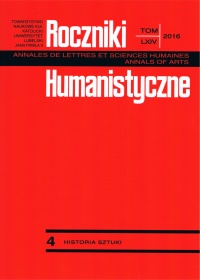The Coral Altar with the Apocalyptic Woman in the Treasury of St Mary’s Basilica in Krakow
Abstract
In Polish museums’ collections there are a few objects made of coral or decorated with it. They are, among others, altars, holy water fonts, crucifixes and other liturgical items. Most often they were bought during Poles’ travels to Italy in the Mannerism and Baroque epochs. In St Mary’s Basilica’s treasury a portable coral altar is kept, dated to the middle of the 17th century, a gift from Maria Józefa, the wife of King August III. It has a golden frame and it is embellished with enamel and coral, and in its center it closes the figure of the Blessed Virgin Mary standing on a crescent, in a radiant coral glory, surrounded by Marian symbols. It is an apotheosis of the Blessed Virgin Mary based on a fragment of the Apocalypse of St John. The figure of Mary is presented with her cosmic attributes: twelve stars around her head; she is clothed with a radiant glory; and she has a crescent under her feet. Around her seven symbolic biblical signs are presented, ones connected in the exegetic tradition with her being the mother of the Messiah. The term Cedrus exaltata – is perceived as the symbol of majesty, sublimity, loftiness, paradisaical beauty, safety. Fons signatus is a sealed spring, a closed one, accessible only to the Mother of God’s Son, chosen by God. Hortus conclusus is the symbol of St Mary’s virginity. Oliva speciosa points to St Mary’s charity, her extraordinary fertility, inner peace, the gift of relieving sufferings. Rosa plantata is a metaphor of wisdom, love, medicine for sinners. Puteus aquarum viventium, a well of living waters, indicates St Mary’s mediation for people redeemed by Jesus. Turris eburnea – the ivory tower is another feature of the Virgin Mary’s beauty, the immaculacy of her body and of her fortitude.
Copyright (c) 2016 Roczniki Humanistyczne

This work is licensed under a Creative Commons Attribution-NonCommercial-NoDerivatives 4.0 International License.





